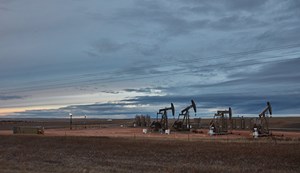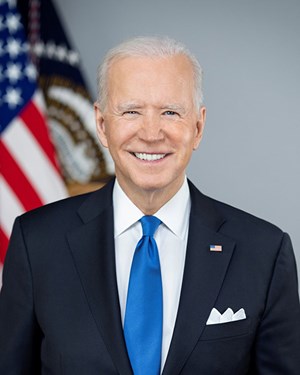Oil and gas industry in for a tumultuous year
It’s going to be a difficult year for the U.S. upstream industry to navigate, given a litany of factors. Among these are fickle commodity prices, war impacts on supply-and-demand and trade, a sudden “pause” in the granting of U.S. LNG export licenses, and the relentless attack on oil and gas by the U.S. federal government and hard-core environmentalists. Yet, on paper, the U.S. E&P sector has a lot going for it.
U.S. AS ENERGY SUPERPOWER

Among the avalanche of dire 2023 news—wars in Ukraine and the Middle East, inflation, interest rates, immigration, etc.—one important story has been shamefully under-reported: The U.S. has become the world’s energy superpower. The U.S. is currently producing more oil than it ever has, and more oil than any other nation in history. The U.S. has also overtaken Qatar to become the world's largest LNG exporter for the first time in history.
Fourth-quarter 2023 U.S. total liquids production reached 21.4 MMbpd—a global record. Of that amount, 13.3 MMbpd were crude and condensate (Fig. 1), with the balance composed of natural gas liquids and biofuels. Not only is the U.S. producing more liquids than any country in history, but the amount of liquids it is exporting nearly equals the total production of Saudi Arabia or Russia. When compared to 2008—when U.S. production was at a 62-year low—and exports were near zero, this turnaround is truly remarkable.
The enormous amount of U.S. production is helping to reduce gasoline prices, diminishing the geopolitical power of OPEC, and reducing inflation. The U.S. production has undermined the influence of OPEC, which failed when it recently attempted to reduce output to increase prices globally.

Meanwhile, estimates have confirmed the market ascendancy of U.S. LNG exports. According to LSEG, full-year U.S. LNG export volumes increased to 88.9 million metric tons (MMmt), while Bloomberg estimated 91.2 MMmt. This achievement is even more remarkable, because the U.S. only entered the LNG export market in 2016. The figures represent a 15% increase in export volumes for 2023, driven by higher rig counts, improved processing efficiencies, and a return to full production of the Freeport LNG plant in Texas, Fig. 2. Fracing advocates have contended that increased U.S. shale production could help stabilize markets in times of crisis, and this has happened.
Rationally, one would expect Biden to take well-publicized credit for these achievements—but you would be wrong. Biden is hardly mentioning them. Fossil fuels will be a crucial issue in his re-election, but oil politics are complicated for Democrats, whose prospects in the November elections may depend on young, environment-focused voters. These voters—many of whom view Biden’s record on the environment as mixed—and environmental activists are pressuring Biden to stop this energy expansion.
WAR ON OIL & NATURAL GAS CONTINUES
The Biden administration continues its assault on the O&G industries.

Notably, in January, the Biden administration “paused” approvals for pending and future applications to export LNG from new projects, an action that could defer decisions on new plants until after the November election, Fig. 3. DOE will conduct a review during the pause to assess the economic and environmental impacts of proposed LNG export projects and determine whether climate change should be considered when deciding projects’ approval. It will take months and will then be open to public comment, which will take more time. Biden stated "During this period, we will take a hard look at the impacts of LNG exports on energy costs, America's energy security, and our environment. The pause sees the climate crisis for what it is: The existential threat of our time.”
This comes as DOE is deciding whether to issue a permit for a large LNG export plant in Louisiana—CP2. Indeed, CP2 is closer to becoming operational than nine other proposed LNG terminals, since it already has secured financing and customers and is awaiting federal permits. More generally, the review could have major implications for the O&G industry, for U.S. influence as an energy superpower, and for the credibility of Biden’s climate pledges and his re-election prospects.
DOE reviews for LNG export permits have lengthened already under Biden to 11 months or more, from seven weeks under former President Trump. The last review of LNG export projects was in 2018, when export capacity was 4 Bcfd. That capacity has tripled and is scheduled to be higher by 2030—U.S. industry has planned $290 billion in new LNG investment over the next decade to increase capacity by 70%. The review troubles investors, who abhor risk and regulatory uncertainty. It jeopardizes new investment and will undermine efforts the U.S. has made towards energy independence.
U.S. LNG growth generated protests from environmentalists and youth groups, and stopping expansion of LNG exports became a major priority for them. Activists contend that LNG projects harm local communities, lock in reliance on fossil fuels, and cause increased methane emissions. Predictably, environmentalists praised the review and canceled a February sit-in protest planned at DOE headquarters. The Vessel Project of Louisiana, which is opposed to LNG build-out, stated, "This is a milestone. It sets the stage for potential rejections and slows down progress of these projects."
The youth-based Sunrise Movement stated that the pause would help Biden with young voters in November. "It needs to be seen that leaders are leading boldly and unapologetically to solve this crisis." Indeed, Biden is hoping the decision helps him win back young voters disenchanted by his approval of the Willow oil project. In announcing the pause, Biden stated, “We will heed the calls of young people and frontline communities, who are using their voices to demand action from those with the power to act.″
Industry was critical of the decision. CP2’s owner, Venture Global, stated, “It appears the administration may be putting a moratorium on the entire U.S. LNG industry. Such an action would shock the global energy market, having the impact of an economic sanction, and send a devastating signal to our allies that they can no longer rely on the U.S.” API stated, “No review is needed to understand the clear benefits of U.S. LNG exports for stabilizing global energy markets, supporting thousands of American jobs and reducing emissions around the world by transitioning countries toward cleaner fuels. Biden’s action is a win for Russia and a loss for American allies, U.S. jobs and global climate progress.''

Also in January, the administration proposed new EPA regulations that would impose fines on O&G companies for methane emissions—a de facto “natural gas tax,” that would be the first direct federal emissions tax, Fig. 4. Beginning in 2024, the regulations would require companies to pay a penalty of $900/ton of methane emitted beyond government-specified limits, with the cost/ton above the limits increasing to $1,200 in 2025 and to $1,500 in 2026. O&G producers criticized the regulations for adding complexity to the regulatory environment and increasing energy costs. The regulations complement a December 2023 EPA proposal for methane detection requirements, which independent O&G companies strongly oppose, because the increased compliance costs would put them at a disadvantage relative to the major firms.
API criticized the proposal, stating, “While we support smart federal methane regulation, this proposal creates an incoherent, confusing regulatory regime that will only stifle innovation and undermine our ability to meet rising energy demand. As the world looks to U.S. energy producers to provide stability in an increasingly unstable world, this punitive tax increase is a serious misstep that undermines America’s energy advantage.”
DOE also has published new appliance efficiency standards for consumer furnaces. They are scheduled to go into effect in late 2028 and require non-weatherized gas furnaces and those used in mobile homes to achieve an annual fuel utilization efficiency of 95%.
The NG industry is suing DOE over these standards, citing cost and other concerns, and contending that it “effectively bans the sale of non-condensing NG furnaces.” The industry noted that DOE data verify that 30% of senior-only households, 26% of low-income households, and 27% of small businesses will experience higher costs, and 39% of households with mobile home gas furnaces would face higher costs. The National Propane Gas Association has a lawsuit pending against DOE that focuses on whether it should have established a separate product class for non-condensing appliances in its energy efficiency rulemakings.
In addition, the Biden administration recently finalized a plan with the fewest offshore O&G leases ever contained in an agency’s 5-year plan and which represents a dramatic phase-down of O&G lease sales. That plan, covering 2024-2029, provides three chances to bid for rights to drill offshore and is the last offshore 2024 drilling auction that will be held. Companies will pay more than $380 million for the rights to drill on 311 tracts in the GOM—26 companies submitted bids.
The sale was mandated by the 2022 Inflation Reduction Act. However, it required a contentious court battle in which environmentalists attempted to reduce the sale and add stipulations to protect Rice’s Whales. After environmentalists and the Biden administration agreed to restrictions on the sale and lease, Chevron, API, and the State of Louisiana filed a lawsuit, and the plaintiffs prevailed.
The O&G industry supported the sale but was critical of the lack of future auctions. API stated, “Although today’s congressionally mandated lease sale is a positive step, the lack of any offshore sales in 2024 is a prime example of the administration’s failure to implement a long-term energy strategy. We urge the administration to reconsider its shortsighted approach and plan today for tomorrow’s energy demand.”
END OF CHEVRON DOCTRINE?

In two of the most closely watched 2024 U.S. Supreme Court energy-related cases, the Court has heard arguments that will have very significant impacts on the O&G industry. The Court is considering the overturn of the “Chevron Doctrine,” which for 40 years has given regulators the benefit of the doubt in lawsuits over their rules and directs courts to defer to federal agency experts, Fig. 5. Chevron, a 1984 Supreme Court case, directs courts to defer to agencies’ interpretations of ambiguous statutes, as long as judges find that agencies’ reading of the law is “reasonable.”
A bedrock of administrative law, Chevron gives agencies broad powers to implement regulations in all policy areas, including energy and the environment. For 40 years, courts have deferred to the judgment of federal agencies with respect to converting laws passed by Congress into detailed regulations. In practice, this has become a license for Congress to write vague laws that delegate legislative power to administrative agencies, and federal regulations have grown exponentially.
If the Court overturns Cheron, the impact would reverberate across the entire federal government. However, the O&G industry, subject to many complex and intersecting energy, permitting, and environmental laws and mandates—and overseen by numerous federal agency regulators including EPA, DOE, the Department of the Interior, the Federal Energy Regulatory Commission, etc.—will be affected the most.
The impact of such a ruling would be significant, because the regulations governing the O&G industry fluctuate in the highly politicized struggle between energy security and the environment. It would make it more difficult for agencies like EPA and DOE to impose new, more demanding rules on industry, which has long been an industry concern. It would transfer that power to the courts. It also would place the existing body of regulations at constant risk of court restriction or reversal, changing the rules under which investments were made and undermining the regulatory certainty required for new investment.
Thus, for the O&G industry, the outcome of the Court decision—due this summer—can hardly be over emphasized.
ZOMBIE LITIGATION IS BACK
In December 2023, a judge in the U.S. District Court for Oregon revived the Juliana v. the U.S. case by granting the plaintiffs’ motion to amend their complaint and directed the parties to begin preparing for trial. This is remarkable, because in 2020, the U.S. Court of Appeals for the Ninth Circuit ordered that the case be dismissed, and in 2021 denied a rehearing. The most disquieting part of the Judge's decision is not the broad assertions of constitutional rights, but her refusal to certify the opinion for interlocutory review. Logically, one would think that the Ninth Circuit's decision would have ended the Juliana litigation, but this was not the case.
The litigation began in 2015, when a group of youth plaintiffs filed suit, alleging that the federal government's failure to control GHGs violates their due process rights to life, liberty, and property, including a right to a "stable climate system," violates their right to equal protection, and fails to uphold its "public trust" obligation.
Those filing these nuisance and tort suits against O&G companies have been successful in keeping their cases out of federal court. Whereas the companies characterize the suits as unwarranted efforts to dictate energy policy in state courts, the plaintiffs in those cases contend they are simply pursuing state law claims in state courts, and that such questions are not worth Supreme Court review.
Predictably, the law firm that filed the Juliana suit has filed its second lawsuit against EPA, accusing it of violating young Californians’ constitutional rights to a healthy life, of discriminating against children by allowing dangerous levels of GHGs, and violating the equal protection and due process clauses of the Fifth Amendment.
This lawsuit solidifies California’s status as the epicenter of climate litigation. It comes three months after California sued the O&G industry, joining a growing number of state, county and city governments attempting to hold O&G companies financially accountable for the effects of climate change. California’s climate liability lawsuit accuses five of the world’s largest oil companies of violating state nuisance and product liability laws and destroying natural resources. California asked a state judge to order oil producers to pay for the costs of dealing with climate change and penalize companies for “lying about the dangers of burning fossil fuels.” Notably and worryingly, this liability case—and others like it—if successful, could cost the oil industry hundreds of billions of dollars.
Thus, the O&G industry faces formidable challenges. In November 2024, elections for President, the Senate, and the House may change the political landscape to something more favorable to the industries. Irrespective, the Biden administration will be in office at least through January 2025, and the next 11 months will be trying ones for the industries.

- The last barrel (February 2024)
- Oil and gas in the Capitals (February 2024)
- What's new in production (February 2024)
- First oil (February 2024)
- E&P outside the U.S. maintains a disciplined pace (February 2024)
- Prices and governmental policies combine to stymie Canadian upstream growth (February 2024)


